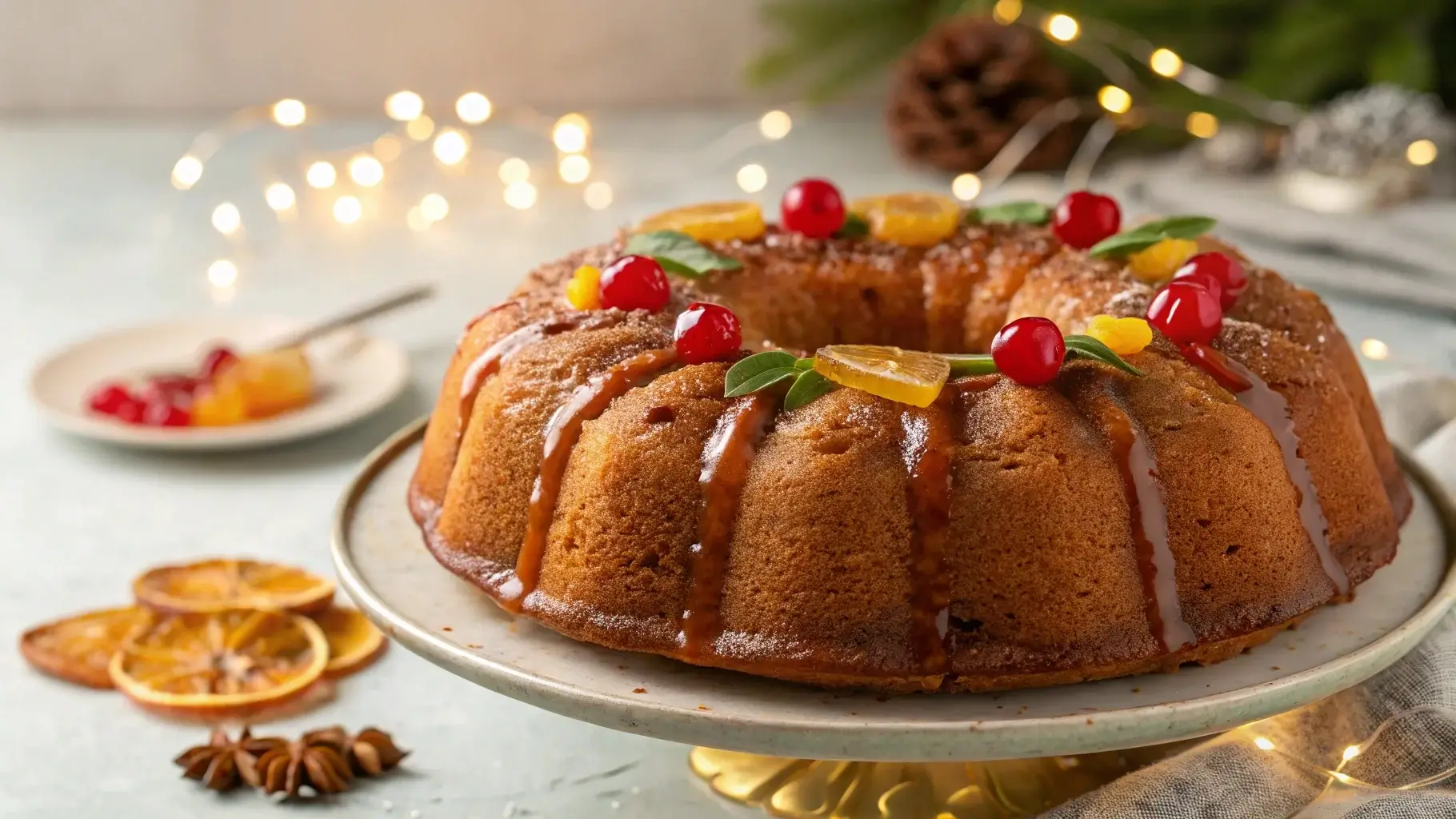There’s something magical about food that can carry you to another place with just one bite. For me, that’s exactly what the Caribbean festival rum cake does—it’s a tropical treasure, rich with boozy, rum-soaked fruits, warm spices, and decadent sweetness. I still remember my first attempt at making this iconic dessert with my husband, Momo. It was a rainy Saturday, and we’d both decided to bring the vibe of the Caribbean right into our kitchen. Between spills of rum and bursts of laughter, we ended up with a cake that was not only a hit at family gatherings but also became a staple of our holiday traditions. In this article, I’ll take you on a flavorful journey through the origins, preparation, and variations of this beloved dessert while sharing tips from our personal baking adventure.
Let’s dive in! 🌴🍰
Table of Contents
Introduction to Caribbean Festival Rum Cake
The Caribbean festival rum cake is a moist, rich dessert known for its intense flavors and festive spirit. It’s traditionally made with rum-soaked dried fruits, a buttery batter, and a glaze of warm rum syrup. This cake is more than just a treat—it’s a cultural icon. In the Caribbean, it’s a staple at weddings, Christmas feasts, and, of course, festivals. Each bite carries a blend of warmth, sweetness, and nostalgia that’s been perfected over generations.
But this cake isn’t just about taste. It embodies family traditions, with many recipes passed down from grandparents to grandchildren. When I first made this with my husband, Momo, I didn’t realize how much of an experience it would be. Between laughing over spills and tasting the rum-soaked fruits, we created a memory as rich as the cake itself.
A Brief History of Caribbean Rum Cake
The history of Caribbean festival rum cake can be traced back to the British settlers who brought fruitcake recipes to the islands. However, the Caribbean version evolved in a unique way, thanks to the abundance of local ingredients like rum, molasses, and spices. During the colonial period, rum production soared, and locals began using it as a key ingredient in baking. The practice of soaking fruits in rum gave the cake its distinctive flavor, making it a treasured part of Caribbean cuisine.
Over time, each island developed its variation. In Jamaica, you’ll find dark, dense black cake made with homemade browning and heavily spiced fruits. Trinidadians prefer a citrusy twist, adding lemon and orange zest to the mix. Puerto Ricans, meanwhile, embrace a buttery, melt-in-your-mouth version known as bizcocho de ron. Despite the differences, one thing remains consistent: this cake is a symbol of celebration and tradition. 🌴
Essential Ingredients for the Perfect Rum Cake
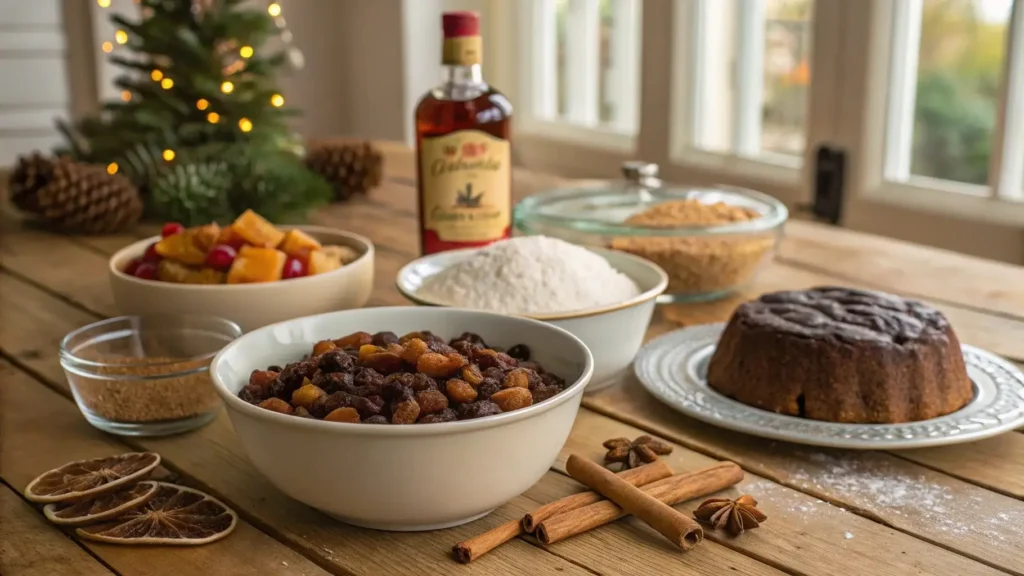
Dried Fruits and Their Role in the Flavor Profile
Dried fruits are the heart of the Caribbean festival rum cake, providing that signature chewy texture and intense, fruity sweetness. Traditional recipes call for raisins, currants, prunes, and dried cherries, although some modern versions add tropical elements like mango or pineapple. These fruits aren’t simply tossed into the mix—they’re soaked in dark rum for weeks, or even months, to build complexity. As Momo and I learned during our first baking attempt, patience is key to achieving that perfect, bold flavor.
Caribbean Rum: A Must-Have Ingredient
It’s impossible to make an authentic Caribbean festival rum cake without rum—it’s the soul of the dish. Dark rums like Appleton Estate or Mount Gay, known for their rich caramel and molasses notes, are preferred for soaking the fruits and drizzling over the cake. Light rums can also be used, depending on the flavor profile you’re aiming for. The rum doesn’t just enhance flavor—it helps preserve the cake, making it ideal for long-term storage.
Key Spices and Aromatics
The warm, fragrant spices are what give this cake its cozy, festive vibe. Cinnamon, nutmeg, allspice, and cloves are essential, infusing the batter with depth and warmth. Many Caribbean families have their own “secret spice blend,” a tradition that’s passed down through generations.
Choosing the Right Sweeteners
While granulated sugar is common, traditional recipes often call for brown sugar or molasses to boost the cake’s richness. The caramel notes from molasses complement the spices and rum beautifully, creating a luscious, aromatic experience.
How to Bake a Caribbean Festival Rum Cake (Step-by-Step Guide)
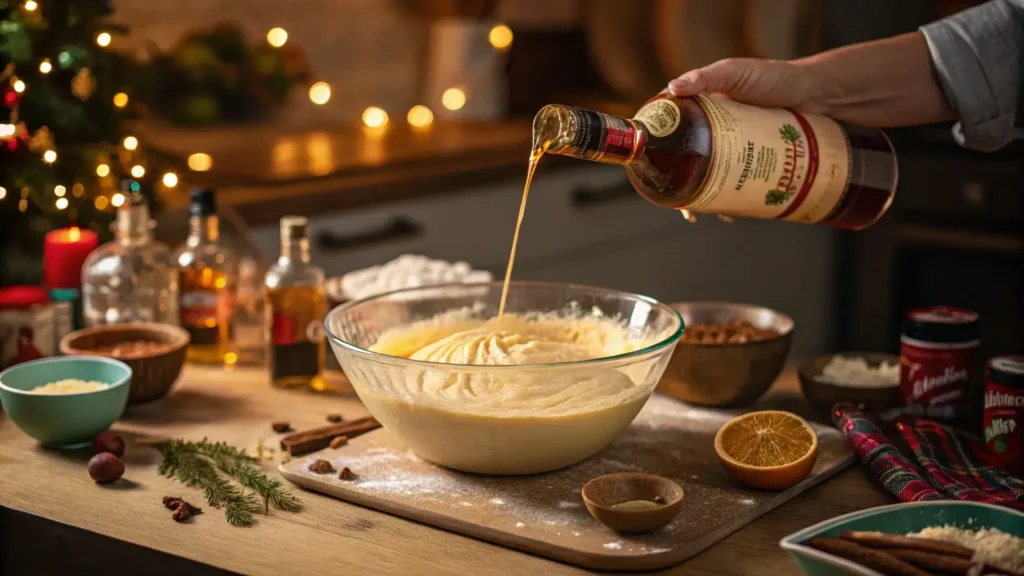
Baking a perfect Caribbean festival rum cake isn’t hard, but it does require attention to detail, especially when it comes to timing and preparation. With Momo by my side, our kitchen was transformed into a tropical haven as we worked through each step. Here’s a foolproof guide for making your own.
Step 1: Preparing the Rum-Soaked Fruits
Start this process at least 1-2 weeks ahead for the best results (or longer if possible). Combine raisins, currants, prunes, and dried cherries in a large glass jar or bowl. Pour enough dark rum over the fruits to submerge them fully, ensuring every piece absorbs the boozy goodness. Seal the container and store it in a cool, dark place.
Tip: If you’re short on time, soaking the fruits overnight with warm rum can speed up the process, but the flavor won’t be as deep.
Step 2: Mixing the Batter – Tips for Texture
- Creaming the Butter and Sugar: In a mixing bowl, cream softened butter and brown sugar until light and fluffy. The butter’s creaminess is essential for that moist texture.
- Adding Eggs: One at a time, beat in eggs, allowing each to incorporate fully before adding the next. This step helps trap air, giving the cake structure.
- Mixing Dry Ingredients: In another bowl, sift together flour, baking powder, salt, and your aromatic spices (cinnamon, nutmeg, and allspice). Gently fold the dry mixture into the wet ingredients, alternating with a splash of milk or rum to keep it moist and smooth.
Step 3: Baking at the Right Temperature
- Preheat your oven to 325°F (160°C). Grease and flour a bundt pan or cake tin to prevent sticking. Pour the batter evenly into the pan, ensuring no air pockets.
- Bake for 50-60 minutes, or until a toothpick inserted into the center comes out clean. Avoid opening the oven too soon, as this can cause the cake to collapse.
Step 4: Creating the Rum Syrup Glaze
While the cake bakes, prepare a syrup by combining melted butter, sugar, water, and rum in a saucepan. Heat until the sugar dissolves completely, then simmer for 2-3 minutes to thicken. This glaze is what gives the cake its signature moistness and boozy kick.
Step 5: Final Soaking and Aging Tips
Once the cake is done, poke small holes into its surface using a skewer. Pour half of the warm rum syrup over the hot cake and let it cool in the pan for about 15-20 minutes. Turn the cake out onto a plate and brush the remaining syrup over the top and sides. For optimal flavor, wrap the cake tightly in plastic wrap and let it age for 2-3 days before serving.
Pro Tip: Store the cake in an airtight container and occasionally brush more rum syrup on it to enhance its taste over time. The longer it sits, the richer the flavor.
Tips for Baking the Perfect Caribbean Festival Rum Cake
Whether you’re a beginner or an advanced baker, there are tips and tricks to make your Caribbean festival rum cake the star of any gathering. Here’s how to level up your baking game, no matter your skill set!
Tips for Amateur Bakers
- Start Simple with Pre-Soaked Fruits: If you’re new to baking, don’t worry about soaking the fruits for weeks. Many stores sell pre-soaked fruits or dried fruit mixes that can be soaked overnight in warm rum for a similar effect.
- Use a Bundt Pan for Even Baking: Bundt pans are beginner-friendly and help distribute heat evenly, ensuring your cake bakes perfectly without undercooked spots. Don’t forget to grease and flour the pan properly to avoid sticking.
- Don’t Overmix the Batter: Gently fold the dry ingredients into the wet ones to prevent a dense or tough cake. Overmixing can ruin the texture, so stop once the flour is just incorporated.
- Follow a Basic Recipe: Stick to the essentials before experimenting. As you gain confidence, you can add personal touches like extra spices or citrus zest.
Tips for Advanced Bakers
- Aging the Cake for Weeks: If you want a deeply flavorful cake, let it age. Wrap the cake in rum-soaked cheesecloth and store it in an airtight container. Brush it with additional rum weekly to enhance the flavor.
- Homemade Browning: For a rich, dark color, make your own browning by caramelizing sugar until it reaches a dark, syrupy consistency. This trick is essential for making Jamaican black cake.
- Custom Spice Blends: Create your unique combination of spices beyond the basics. A dash of cardamom or star anise can give the cake a signature twist.
- Experiment with Liquor Infusions: Don’t limit yourself to just rum. Experiment with a mix of rum and brandy or a spiced rum to elevate the cake’s complexity.
With these tips, you’ll master the Caribbean festival rum cake and impress everyone, no matter the occasion! 🌴
Variations of Caribbean Rum Cake Across the Region
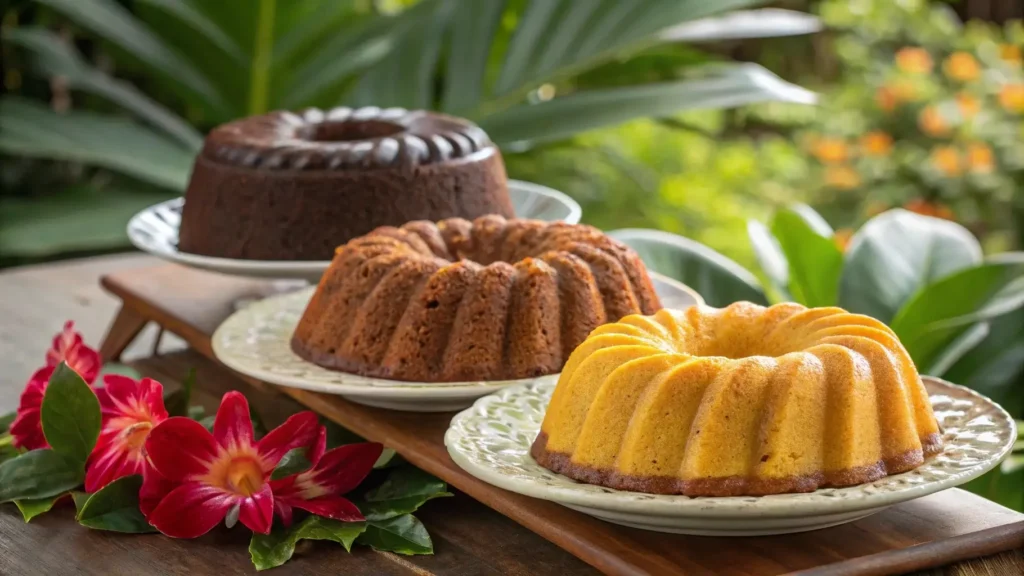
The Caribbean festival rum cake has countless variations, each reflecting the culinary traditions of its respective island. Let’s explore some of the most popular ones.
Jamaican Black Cake: Rich, Dark, and Dense
The Jamaican black cake, sometimes referred to as Christmas cake, is a dense, deeply flavored version of the classic rum cake. Its dark color comes from the use of burnt sugar (also known as browning) and the extended soaking of fruits. With its molasses-like sweetness and intense spices, this version is often served at weddings and holiday feasts.
Trinidadian Rum Cake: Moist with Citrus Notes
Trinidad’s take on rum cake includes bright citrus flavors, often from the addition of orange and lemon zest. The batter tends to be a bit lighter, and some recipes even call for a touch of citrus juice. The result? A tropical twist on the traditional dessert that’s incredibly moist and fragrant.
Puerto Rican Rum Cake: Light and Buttery
Known as bizcocho de ron, the Puerto Rican variation is known for its light, buttery texture. It often incorporates vanilla extract, coconut milk, and a generous amount of dark rum, giving it a melt-in-your-mouth softness. Unlike the denser Jamaican version, this one is airy and pairs beautifully with whipped cream or a side of fresh fruit.
These regional twists highlight the versatility of the Caribbean festival rum cake, making it an endlessly adaptable treat that can suit any occasion. Whether you prefer a dark, rich version or a light and citrusy one, this dessert offers a taste of the Caribbean’s diverse culinary landscape.
For more tropical desserts, check out this Raspberry Zinger Poke Cake for a fruity and indulgent treat!
Tips for Serving and Storing Rum Cake
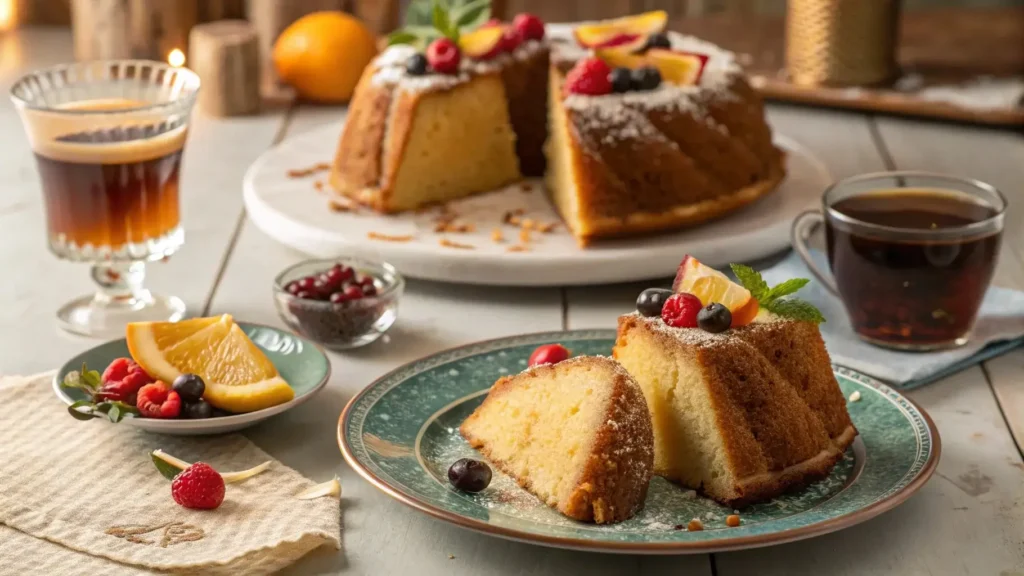
When your Caribbean festival rum cake is ready to serve, you want to make sure you do it justice. This dessert’s rich, boozy character can be enhanced with thoughtful serving techniques and proper storage to keep it moist for days—or even weeks.
Ideal Serving Temperature
The cake is best served at room temperature. This allows the flavors of the rum and spices to shine through and ensures the cake retains its signature moist texture. For a luxurious twist, try lightly warming individual slices in the microwave for 10-15 seconds before serving.
Pairing Suggestions: Coffee, Rum Cocktails, or Ice Cream
Pairing your Caribbean festival rum cake with complementary flavors can take the experience to another level. A strong cup of Caribbean-style coffee balances the cake’s sweetness, while a rum cocktail, like a dark and stormy, enhances the boozy richness. For a more indulgent dessert, serve it with a scoop of vanilla ice cream or a drizzle of warm caramel sauce.
Storage Tips to Preserve Moisture and Flavor
To store the cake, wrap it tightly in plastic wrap, ensuring no air can get in. If you plan to store it for longer periods, place the wrapped cake in an airtight container. For maximum flavor retention, brush additional rum syrup on the cake every few days. Stored properly, the cake can last for weeks and even improve over time as the flavors deepen. Refrigeration is optional but recommended in warm climates to prevent spoilage.
(Curious about making another dessert that stays fresh for days? Check out this Moist Chocolate Orange Almond Cake for a citrusy twist.)
Health Considerations and Nutritional Facts
While the Caribbean festival rum cake is undeniably delicious, it’s important to enjoy it in moderation. With its rich ingredients like butter, sugar, and rum, the cake is high in calories but also provides comfort and nostalgia that are hard to resist.
Caloric and Nutritional Breakdown
A typical slice of rum cake (around 100-150g) can contain anywhere from 300 to 450 calories, depending on the ingredients and serving size. The cake is also high in carbohydrates due to the dried fruits and sugar. Although it provides small amounts of fiber from the fruits and protein from the eggs, its primary nutritional contribution comes from its energy content.
Tips for Making a Healthier Version
You can lighten up your rum cake without losing too much flavor by making a few ingredient swaps. Try using whole wheat flour or almond flour instead of refined flour to add fiber. Replace some of the butter with Greek yogurt for a lower-fat option. Reducing the amount of sugar or using natural sweeteners like honey or coconut sugar can also make a difference. Additionally, consider soaking the fruits in rum for less time or using less syrup if you want to cut back on the alcohol content.
Frequently Asked Questions (FAQ) about Caribbean Festival Rum Cake
Whether you’re making a Caribbean festival rum cake for the first time or perfecting your technique, these commonly asked questions can help you along the way.
1. What type of rum is best for making Caribbean rum cake?
Dark rum is the most popular choice for this cake due to its deep, caramel-like flavors. Brands like Appleton Estate, Mount Gay, and Captain Morgan work well. If you prefer a lighter flavor, you can use a golden or light rum, but dark rum gives the cake its signature richness.
2. How long should you soak fruits for a rum cake?
Traditionally, the fruits are soaked for at least one week, but many Caribbean families soak them for months or even a year! If you’re short on time, you can soak them overnight in warm rum, but the longer the soak, the richer the flavor.
3. Can you make a non-alcoholic version of Caribbean rum cake?
Yes! You can replace the rum with rum extract for flavor or use fruit juice (like grape or orange juice) for soaking the fruits. Just note that the cake won’t have the same depth of flavor.
4. What makes Caribbean rum cake different from regular rum cake?
The difference lies in the preparation and ingredients. The Caribbean festival rum cake uses rum-soaked dried fruits, warm spices, and a longer aging process to develop its complex flavors. It’s more fragrant, moist, and rich compared to standard versions.
Why You Should Try Making Caribbean Festival Rum Cake
The Caribbean festival rum cake isn’t just a dessert—it’s a sensory experience. Every bite takes you on a journey through layers of flavor, from the warm spices to the boozy, rum-soaked fruits. But beyond its taste, it carries cultural significance and the joy of family traditions, which is exactly what made my first baking attempt with Momo so special.
Whether you’re preparing it for a holiday gathering or simply indulging your sweet tooth, this cake is the perfect combination of comfort and celebration. What’s more, its versatility allows you to experiment with regional variations or tweak the recipe to suit your preferences. Once you’ve mastered it, you’ll see why it’s a staple at Caribbean weddings, Christmas feasts, and festivals.
So, if you’re looking for a dessert that’s rich in both flavor and history, give this Caribbean festival rum cake a try. You might just create memories as sweet as the cake itself. 🌴✨
For more delicious inspiration, explore this Moist Red Velvet Cake that’s perfect for special occasions.
